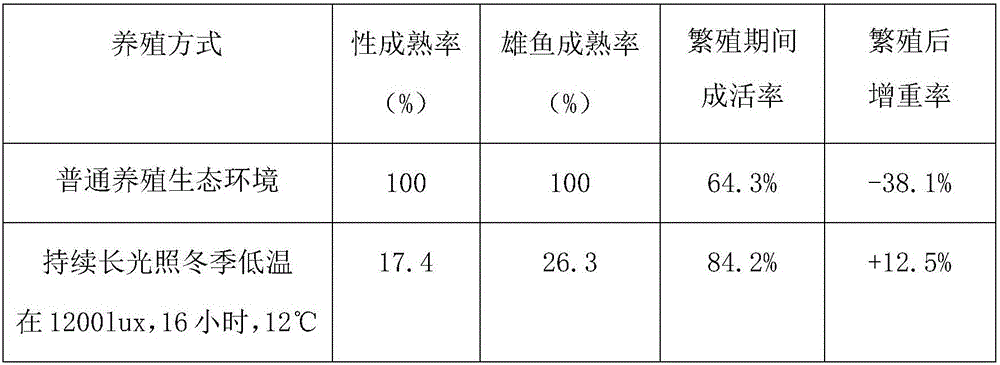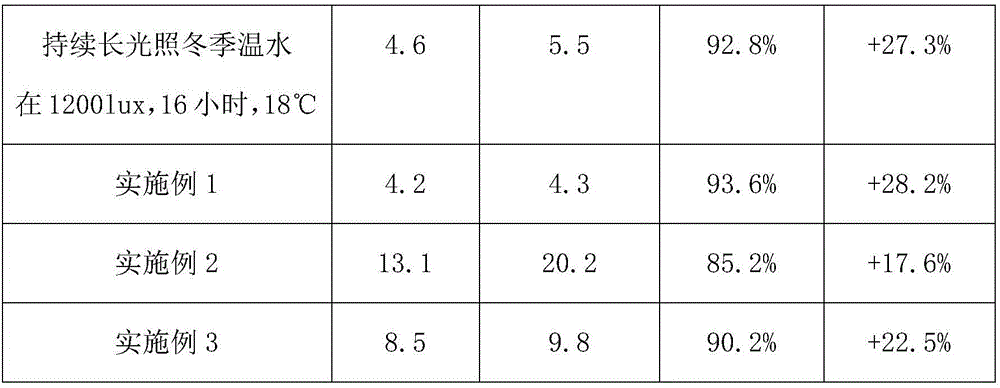Method for increasing survival rate and growth rate of alosa sapidissima in breeding season
A technique of survival rate and growth rate is applied in the field of improving the survival rate and growth rate of shad in the breeding season, which can solve the problems of reducing the mortality rate of shad, uncontrollable disease condition, long duration, etc., and achieves prolonging feeding time, and the method is simple and reliable. , the effect of enhancing the positivity
- Summary
- Abstract
- Description
- Claims
- Application Information
AI Technical Summary
Problems solved by technology
Method used
Image
Examples
Embodiment 1
[0019] A method for improving the survival rate and growth rate of shad in the breeding season, comprising the following steps: in autumn, adopt long photoperiod → in winter, adopt long photoperiod, warm water, brackish water culture mode → in spring, continue to adopt long photoperiod Periodic, warm water, brackish water aquaculture mode → In summer, use natural light and a freshwater aquaculture mode with higher water temperature.
[0020] The specific implementation process is as follows:
[0021] 1. Preparation of shad culture ponds: The fish ponds can be round or rectangular with rounded corners, with an area of 50-300 square meters and a water depth of 0.8-2.0 meters. Aeration or wheel aerators can be used to increase oxygen in fish ponds.
[0022] 2. Preparation of circulating water purification system: water purification can be divided into four parts, namely solid waste separation, aerobic nitrification, anaerobic nitrification and ultraviolet disinfection. The fi...
Embodiment 2
[0030] A method for improving the survival rate and growth rate of shad breeding season, the basic method is the same as in Example 1, and the difference from Example 1 is: the adjustment of the photoperiod, temperature and salinity during cultivation:
[0031] a. In autumn, adopt a long photoperiod: that is, the sunshine time is 18 hours, the light intensity is kept at 800lux, and the temperature is not lower than 22°C, and freshwater or brackish water farming mode can be used;
[0032] b. In winter, adopt long photoperiod, warm water, and brackish water aquaculture mode: that is, the sunshine time is 18 hours, the light intensity is kept at 800lux, the temperature is not lower than 15°C, and the salinity is 25‰;
[0033] c. In spring, continue to adopt the long photoperiod, warm water, and brackish water aquaculture mode: that is, the sunshine time is 18 hours, the light intensity is kept at 800lux, the temperature is not lower than 15°C, and the salinity is increased to 35‰;...
Embodiment 3
[0036] A method for improving the survival rate and growth rate of shad breeding season, the basic method is the same as in Example 1, and the difference from Example 1 is: the adjustment of the photoperiod, temperature and salinity during cultivation:
[0037]a. In autumn, adopt a long photoperiod: that is, the sunshine time is 15 hours, the light intensity is kept at 1900lux, the temperature is not lower than 20°C, and freshwater or brackish water farming mode can be used;
[0038] b. In winter, adopt a long photoperiod, warm water, and brackish water aquaculture mode: that is, the sunshine time is 15 hours, the light intensity is kept at 1900lux, the temperature is not lower than 16°C, and the salinity is 17‰;
[0039] c. In spring, continue to adopt the long photoperiod, warm water, and brackish water aquaculture mode: that is, the sunshine time is 15 hours, the light intensity is kept at 1900lux, the temperature is not lower than 16°C, and the salinity is increased to 25‰;...
PUM
 Login to View More
Login to View More Abstract
Description
Claims
Application Information
 Login to View More
Login to View More - R&D
- Intellectual Property
- Life Sciences
- Materials
- Tech Scout
- Unparalleled Data Quality
- Higher Quality Content
- 60% Fewer Hallucinations
Browse by: Latest US Patents, China's latest patents, Technical Efficacy Thesaurus, Application Domain, Technology Topic, Popular Technical Reports.
© 2025 PatSnap. All rights reserved.Legal|Privacy policy|Modern Slavery Act Transparency Statement|Sitemap|About US| Contact US: help@patsnap.com


